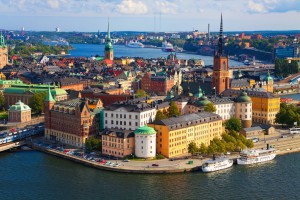Geiranger
Geiranger
Nestled at the edge of the Geiranger Fjord, this charming town offers you the opportunity to observe amazing panoramic views from its famed mountain peak, Mount Dalsnibba.
|
Destination Guide
|
Trondheim
Trondheim
Norway's royal residence since 997 AD, when King Olaf I founded Trondheim, the city still boasts Stiftsgarden, the huge wooden palace. A century later, St. Olaf II began to perform miracles for the people, making Trondheim a major pilgrimage destination. Be sure to visit Nidaros Cathedral, where the Norwegian kings are still crowned, which is certainly one of Europe's premier Gothic-style churches.
|
Destination Guide
|
|
Mosjoen
|
|
Narvik
Narvik
Narvik is an ice-free port in northern Norway. This city fell to the Germans in World War II when they invaded Norway on April 9, 1940. Intense fighting broke out in the city and when the tide is right, you can still see the bow of the Gerrman destroyer, the Georg Thiel portruding from the harbor. Main tourist attractions in Narvik include Killer-Whale safaris in late fall and winter and various outdoor activities, such as hiking, fishing, cmaping and mountain climbing. Many also come to the harbor to scuba dive to explore the ship graveyard leftover from the war.
|
Destination Guide
|
Alta
Alta
The Rock carvings at Alta, dating from circa 4200 BC to 500 BC, are on the UNESCO list of World Heritage Sites. In additon, the Komsa culture was named after the Komsa mountain in Alta municipality, where the first archeological remains were discovered.
In World War II, the German battleship Tirpitz used Altafjord as a harbor, and was damaged here by attacking allied warplanes.
Altasaken in 1979 made headlines for weeks, as many people (especially environmentalists) demonstrated and used civil disobedience to prevent the building of a dam in order to produce hydropower. The dam was built, however, and the river still offers good salmon fishing.
|
|
Honningsvag
Honningsvag
The world's northernmost village, Honningsvag, the gateway to the North Cape, is a completely modern fishing harbor set in a land of forests, fjord waters, and crashing waterfalls, everything bathed in summer by the eerie light of the midnight sun. Only the chapel withstood the German destruction of 1944. It's some 50 miles nearer to the North Pole than Hammerfest, on the Alta-Hammerfest bus route.
|
Destination Guide
|
Ivalo
Ivalo
Ivalo (590 mi/950 km north of Helsinki) has the primary airport for the far northern part of the country, but there's little to see in the town itself. Instead, visit the nearby town of Inari to see the open-air museum, explore the Siida Sami cultural center and take a cruise on Lake Inari. Plan to stay two nights. The resort in Saariselka offers excellent hiking, fishing, hunting and, in winter, cross-country skiing. The Hotel Kakslauttanen and Igloo Village has glass igloos, open to the sky and perfect for viewing the northern lights on clear nights. It also manages the almost adjacent Santa's Resort, an enchanting reenactment of all things Christmas. Nearby Lemmenjoki National Park is a perfect place for gold panning, river rafting and exploring Sami culture.
|
Destination Guide
|
Rovaniemi
Rovaniemi
The town of Rovaniemi boasts many modern buildings that border the unspoiled Lapland countryside and Artic wilderness. There are many great museums to visit as well as excellent hiking and skiing trails. The Ranua Zoo and Santa Park are also great places to visit!
|
|
Kuopio
Kuopio
Kuopio is perhaps best known to visitors for its breathtakingly beautiful lakeland setting as well as for its Puijo Tower and lively Marketplace. Today Kuopio is increasingly renowned as a centre for high-class education and research and as a city that promotes a deversified economy, internationalism and high technology while preserving its unspoilt environment
|
Destination Guide
|
Odense
Odense
Odense, on the island of Fyn (Funen in English), is often called the "Garden of Denmark" and is where Hans Christian Andersen lived. The easy drive to Odense, 90 mi/140 km southwest of Copenhagen, reveals beautiful rolling hills and blue lakes, and it takes you across the relatively new Storebaeltsbroen—at 13 mi/21 km, it's one of Europe's longest bridges. Andersen's childhood home is in Odense, and there's a museum with many of his letters, manuscripts and personal items. Next to the original museum, you'll find a children's activity house named Fyrtoejet (The Tinderbox), where children can engage in such activities as drawing, face painting, acting, music making and storytelling, as well as listen to fairy tales. All activities are organized around a specific theme, usually drawn from one of Andersen's stories. Every summer, the city holds a festival in his honor, which includes open-air performances of his fairy tales. Other sights around town include Gothic-style St. Canute's Cathedral (named after King Canute, who was murdered by discontented subjects in 1086), a castle (formerly the monastery of a medieval order of chivalry), a university and a railroad museum with old engines and coaches once used by the royal family. Much of the area looks as it did hundreds of years ago, with cobblestoned streets, shuttered windows and flower boxes. Spend some time relaxing in the outdoor cafes and watching the musicians and street performers (in summer only). While you're on the island, spend at least a couple of hours at Den Fynske Landsby (a re-creation of an 18th-century Danish village) and visit well-preserved Egeskov Castle (moat and gardens with concerts in the summer, as well as a vintage car museum next door) and the beautiful seaport of Svendborg (walk along the harbor and eat at one of the seafood restaurants). A number of picturesque islands and towns can be reached from Svendborg by ferry, including Aeroe, with its main town, Aeroeskoebing, and Kerteminde, a charming town northeast of Odense that was once the home of African-American painter William H. Johnson and his wife, Danish weaver Holcha Krake. If Viking sites interest you, spend some time at Ladby Ship (a burial site 10 mi/16 km east of Odense). You can rent bicycles in Odense—the city itself is very flat. We suggest a long day, at the very least, to see everything in the area. http://www.visitodense.com.
|
Destination Guide
|
Aalborg
Aalborg
Aalborg has a worldwide reputation for the production of Aquavit (schnapps), but this strong Scandinavian liquor isn’t the only attraction. Once a powerful Viking port, Aalborg served as the base for the Vikings’ predatory pilgrimages. Its old town attracts with its picturesque setting, and the port is well located for excursions into the scenic surrounding area. Jutland is considered the heartland of Denmark, a land of crystal fjords, stark moors, dense forests, and small medieval towns. With the additional attraction of miles of sandy beaches, the peninsula is the most popular domestic holiday area. The city’s pride in its heritage is evident in the carefully preserved burgher houses built by merchants during the Renaissance. Along the road north to the popular resort of Skagen at the tip of Jutland, huge, shifting dunes up to 35 feet high present some of Denmark’s most stunning sights.
|
Destination Guide
|
Kristiansand
Kristiansand
Set on the scenic southern tip of Norway, at a magical spot with more sunshine than anywhere else in Scandanavia, little Kristiansand is Nature’s playground. Its spacius, ice-free harbor is ringed with thousands of tiny islands, a haven for swimmers, boaters and sport fishermen. Along the waterfront, in the silent Christiansholm fortress, and the charming houses of the historic center, you’ll find a peaceful serenity.
|
Destination Guide
|
Stavanger
Stavanger
Founded in the 8th century and one of Norway's oldest towns, Stavanger is situated along the Byfjord, an arm of the Stavangerfjord. A bishop ruled the city from the twelfth through seventeenth centuries. At the end of the eighteenth century, Stavanger had developed a successful merchant shipping fleet and during the next century developed herring fishing and canning industries. Appealing echoes of that proud heritage live on amid the evocative cobbled streets of Gamle (Old) Stavanger, whose whitewashed 18th century houses are probably northern Europe's best-preserved community of wooden houses. It has a well-preserved 12th century stone church.
|
Destination Guide
|
Bergen
Bergen
With its spectacular setting among seven hills, Bergen is one of the most beautiful and enjoyable cities in Norway. Most sites are within an easy walk from the harbor. From fine surviving medieval buildings to a series of good museums such as Fishery Museum and Old Bergen open-air museum, Bergen offers a wide variety of attractions. Its scenic beauty can best be appreciated from Mt. Floyen and is captivating. Enjoy this lovely city by taking a stroll to the old part of town, passing impressive 12th-century Bergenhus fortress. Old Hanseatic Wharf, called Bryggen, is where reconstructed gabled buildings house workshops, boutiques and restaurants. St. Mary's Church is Bergen’s oldest building and one of the finest Norman churches in Norway. Rasmus Meyers Collection is a rambling townhouse featuring one of the best collections of Norwegian art, including an upper floor devoted almost entirely to Munch. Bergen boasts numerous historic buildings dating from medieval times: Bergenhus Fortress; Rosenkrantz Tower; Haakon’s Hall.
|
Destination Guide
|
|
Ullensvang
|
|
Helsinki
Helsinki
Often referred to as "Pearl of the Baltic," this neat city is known for impressive architecture, wide boulevards, and beautiful harbor. Grand Senate Square, dominated by exquisite Tuomio Church and onion domes of Russian Orthodox Uspenski Cathedral, is an example of neo-Classical, Empire-style impressive architecture. Visit the lively harborfront market and Temppeliaukioa Church (Rock Church), which was created in the 60's from man-made and natural materials. Finland’s musical heritage comes alive in great Finlandia Hall, designed by renowned architect Alvar Aalto. Finland’s beloved composer, Jean Sibelius, is remembered by a beautiful monument on Helsinki’s outskirts. Helsinki has good museums displaying everything from art to architectural design. Open-air Museum - the small wooded island of Seurasaari - has a collection of vernacular buildings assembled from all over Finland which provide insight into how country folk lived until recently. Suomenlinna Fortress is the largest in the world and often called Gibraltar of the North.
|
Destination Guide
|
Stockholm
Stockholm
Stockholm is Sweden’s strikingly elegant and beautiful capital. Stockholm, noted for its outstanding architecture, is one of Scandinavia’s most attractive cities. In addition to its many man-made monuments, Stockholm boasts natural beauty - with one-third of the city’s total land area devoted to parks. As the country’s major city, Stockholm offers a wealth of monuments and sites, fine museums, and a rich culture. There are also hundreds of excellent restaurants, as well as a great selection of trendy boutiques and exciting nightclubs. Visitors should start their exploration of Stockholm with the Gamla Stan, the Old Town on Stadsholmen; an island in the center of the city, it has retained its medieval charm. The maze of narrow, cobbled streets, full of art studios, boutiques, antique shops, nightclubs and bars, is best explored on foot.
|
Destination Guide
|
Copenhagen
Copenhagen
Wonderful Copenhagen is a city of bridge-spanned canals, copper-roofed buildings and manicured parks. This famous Baltic seaport is one of Europe’s loveliest capitals and the seat of the oldest monarchy in the world. Copenhagen is a focus for commerce, culture, industry and cosmopolitan atmosphere. The locale of Hans Christian Andersen’s enchanting tale of The Little Mermaid, Copenhagen is known as Denmark’s fairy-tale city. Its impressive theaters, museums and churches are of interest to many visitors; the best-loved attractions include the world-famous Tivoli Gardens, the Langelinie Harbor with its Little Mermaid statue and the busy shopping promenade known as Strøget.
|
Destination Guide
|
Oslo
Oslo
Oslo, Norway’s capital and largest city, is encircled by wooded hills and snowcapped peaks. The city displays a mixture of several architectural styles. A full range of activities includes art galleries, museums, restaurants, theaters and nightclubs. Other points of interest include Royal Palace; Frogner Park, known for its famous Vigeland sculptures; Holmenkollen, where international skiing events take place; imposing Åkershus Castle; and Bygdøy Peninsula, home to some of Oslo’s most important museums. Many attractions can be explored on foot. Oslo's City Hall ranks as the most distinctive part of Oslo’s waterfront. The art portrays the country's different historical and domestic phases. Munch Museum, which is dedicated to the life work of Norway’s famous painter, contains more than 5,000 drawings and paintings. National Gallery has the nation’s largest collection of Norwegian art and some of Munch’s best-known works. Åkershus Fortress & Castle, transformed into a Renaissance palace in the 17th century, houses Norway’s Resistance Museum.
|
Destination Guide
|






